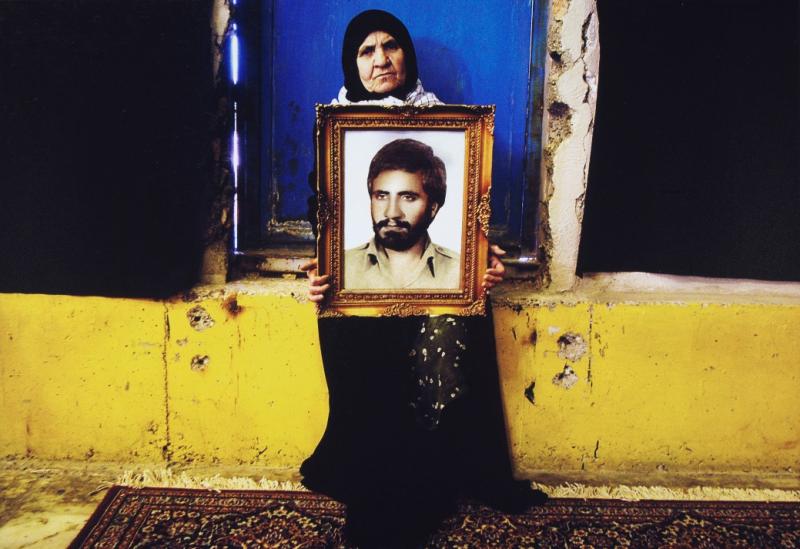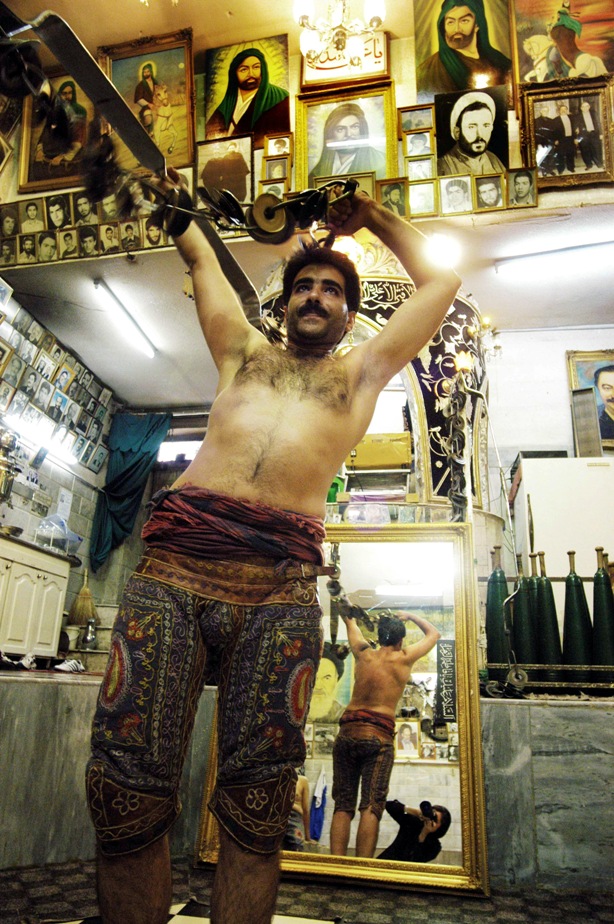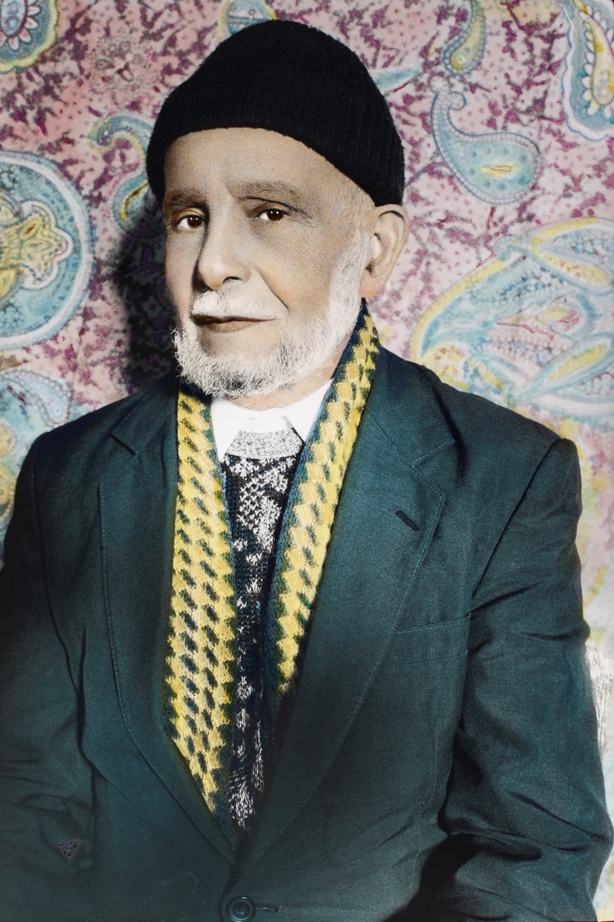Light from the Middle East: New Photography, Victoria & Albert Museum | reviews, news & interviews
Light from the Middle East: New Photography, Victoria & Albert Museum
Light from the Middle East: New Photography, Victoria & Albert Museum
Two national museums combine to show a turbulent region 'writing with light'

This compilation of nearly 90 photographs by 30 photographers from 13 different countries of the Middle East is literally and metaphorically illuminating. The Paris-based Iranian photographer Abbas puts it thus: “I write with light.”
Framed in three different labelled sections - Recording, Reframing, Resisting – the exhibition is an unusual and welcome collaboration between the Victoria & Albert and British Museums, with support to the tune of £100,000 from the Art Fund. The gift was shared between the two museums who each bought for their own collections. The results, dating from the Iranian revolution of 1979 to the present day, are eye-opening. Immensely diverse in style and subject, they are united by a complex web of emotional ambiguity and ambivalence, and irradiated by an unflinching gaze at the contradictions of turbulent societies. The whole shows the gamut of photography - reportorial, although always dictated by the individual eye, consciously interpretative, even subversive.
 Abbas’s prints for Magnum are vignettes, quietly terrifying in the passion they so subtly record of the Iranian revolution. Crowds yell, clerics speechify, young men in white turbans in a disciplined row carry rifles, the Shah’s portrait is being on fire. These are the oldest images on view and of course are far less than a lifetime away. There are more recent, sadly evocative images in colour by the Tehran-based Newsha Tavakolian, from a 2006 series Mothers of Martyrs (main image). Ageing women hold up photographs of their sons, formally framed and eternally young, killed in the costly Iran-Iraq war.
Abbas’s prints for Magnum are vignettes, quietly terrifying in the passion they so subtly record of the Iranian revolution. Crowds yell, clerics speechify, young men in white turbans in a disciplined row carry rifles, the Shah’s portrait is being on fire. These are the oldest images on view and of course are far less than a lifetime away. There are more recent, sadly evocative images in colour by the Tehran-based Newsha Tavakolian, from a 2006 series Mothers of Martyrs (main image). Ageing women hold up photographs of their sons, formally framed and eternally young, killed in the costly Iran-Iraq war.
Subtly absurd is the work of Meharanah Atashim, another young woman photographer living in Tehran, from a series called Zourkhaneh (2004), which explores the delighted posturings in the all-male gymnasium, her own self-portrait inserted by way of mirrors (pictured above right). Shadi Ghadirian’s 1998 series Qajar (pictured below left) shows demure, handsome, traditionally dressed young women in a photographer’s studio complete with painted architectural background and traditional furniture. One pair of women hold up a mirror reflecting a full bookcase, another pair a man's bicycle, while several single women wearing just a headscarf embrace western items – a can of Pepsi, a basket of foodstuffs - while a ghetto blaster sits demurely on a table. Such images are not only beautiful and arresting in their own right, but subvert the western clichés of the monolithic nature of some Islamic societies.
 There are surprises: the survivors of the oldest Yemeni community in Britain, the sailors of South Shields (pictured overleaf), are recorded in formal portraits hand-coloured by the Egyptian photographer Youssef Nabil, who now lives in New York. He is one of a significant number of the photographers on display now either living in the West or commuting internationally. The Iranian Mitra Tabrizian studied in London and is professor of photography at the University of Westminster. Her arresting posed tableau, Tehran (2006), shows a frieze of men and women of all ages, most of the women in hijabs, walking on wasteland surrounding desolate new apartment blocks, overlooked by a vast poster of two ayatollahs. Apart from a disconsolate taxi, the only hint of colour is in the bright red plimsolls worn by a scarfed young girl.
There are surprises: the survivors of the oldest Yemeni community in Britain, the sailors of South Shields (pictured overleaf), are recorded in formal portraits hand-coloured by the Egyptian photographer Youssef Nabil, who now lives in New York. He is one of a significant number of the photographers on display now either living in the West or commuting internationally. The Iranian Mitra Tabrizian studied in London and is professor of photography at the University of Westminster. Her arresting posed tableau, Tehran (2006), shows a frieze of men and women of all ages, most of the women in hijabs, walking on wasteland surrounding desolate new apartment blocks, overlooked by a vast poster of two ayatollahs. Apart from a disconsolate taxi, the only hint of colour is in the bright red plimsolls worn by a scarfed young girl.
 And then there is religion. Aleppo-based Issa Touma has recorded over a 10-year period a festival of ecstasy, dancing, processing and self-torture collected in Sufis: The Day of al-Ziyara. The Saudi Ahmed Mata mimics the end of the Haj, the annual pilgrimage to Mecca, which cannot be photographed: a black cube of a magnet is surrounded by circular rows of metal filings from a 2011 series called Magnetism. The Iranian Teraneh Hemani’s Most Wanted (2006) is a manipulated photograph of the blurred faces of an octet of men and women; it is a visual reflection of the search for recognisable identities in a region beset by religious, political and cultural schisms. Hemani now lives in San Francisco, and much of her art deals with exile and Diaspora. Next to it, in the Resisting section, is Human Tapestry (2009), a huge mosaic of thousands of group photographs arranged almost like a decorative carpet, by Sadegh Tirafkan, an Iranian whose family was expelled from Iraq after the 1968 coup.
And then there is religion. Aleppo-based Issa Touma has recorded over a 10-year period a festival of ecstasy, dancing, processing and self-torture collected in Sufis: The Day of al-Ziyara. The Saudi Ahmed Mata mimics the end of the Haj, the annual pilgrimage to Mecca, which cannot be photographed: a black cube of a magnet is surrounded by circular rows of metal filings from a 2011 series called Magnetism. The Iranian Teraneh Hemani’s Most Wanted (2006) is a manipulated photograph of the blurred faces of an octet of men and women; it is a visual reflection of the search for recognisable identities in a region beset by religious, political and cultural schisms. Hemani now lives in San Francisco, and much of her art deals with exile and Diaspora. Next to it, in the Resisting section, is Human Tapestry (2009), a huge mosaic of thousands of group photographs arranged almost like a decorative carpet, by Sadegh Tirafkan, an Iranian whose family was expelled from Iraq after the 1968 coup.
Many of the photographs respond to the moment, while others are elaborate set-ups. The whole is a snapshot of the extraordinary complexity of the region, where the individual biographies attest to the sheer stamina of each artist to produce photographs to report, reflect, interpret, subvert and instruct, while never losing sight of the necessity to capture the viewer by seducing the eye. The detailed accompanying catalogue contains interviews and biographies which testify to the region’s growing enthusiasm for photography.
Share this article
The future of Arts Journalism
You can stop theartsdesk.com closing!
We urgently need financing to survive. Our fundraising drive has thus far raised £49,000 but we need to reach £100,000 or we will be forced to close. Please contribute here: https://gofund.me/c3f6033d
And if you can forward this information to anyone who might assist, we’d be grateful.

Subscribe to theartsdesk.com
Thank you for continuing to read our work on theartsdesk.com. For unlimited access to every article in its entirety, including our archive of more than 15,000 pieces, we're asking for £5 per month or £40 per year. We feel it's a very good deal, and hope you do too.
To take a subscription now simply click here.
And if you're looking for that extra gift for a friend or family member, why not treat them to a theartsdesk.com gift subscription?
more Visual arts
 'We are bowled over!' Thank you for your messages of love and support
Much-appreciated words of commendation from readers and the cultural community
'We are bowled over!' Thank you for your messages of love and support
Much-appreciated words of commendation from readers and the cultural community
 Folkestone Triennial 2025 - landscape, seascape, art lovers' escape
Locally rooted festival brings home many but not all global concerns
Folkestone Triennial 2025 - landscape, seascape, art lovers' escape
Locally rooted festival brings home many but not all global concerns
 Sir Brian Clarke (1953-2025) - a personal tribute
Remembering an artist with a gift for the transcendent
Sir Brian Clarke (1953-2025) - a personal tribute
Remembering an artist with a gift for the transcendent
 Emily Kam Kngwarray, Tate Modern review - glimpses of another world
Pictures that are an affirmation of belonging
Emily Kam Kngwarray, Tate Modern review - glimpses of another world
Pictures that are an affirmation of belonging
 Kiefer / Van Gogh, Royal Academy review - a pairing of opposites
Small scale intensity meets large scale melodrama
Kiefer / Van Gogh, Royal Academy review - a pairing of opposites
Small scale intensity meets large scale melodrama
 Jenny Saville: The Anatomy of Painting, National Portrait Gallery review - a protégé losing her way
A brilliant painter in search of a worthwhile subject
Jenny Saville: The Anatomy of Painting, National Portrait Gallery review - a protégé losing her way
A brilliant painter in search of a worthwhile subject
 Abstract Erotic, Courtauld Gallery review - sculpture that is sensuous, funny and subversive
Testing the boundaries of good taste, and winning
Abstract Erotic, Courtauld Gallery review - sculpture that is sensuous, funny and subversive
Testing the boundaries of good taste, and winning
 Edward Burra, Tate Britain review - watercolour made mainstream
Social satire with a nasty bite
Edward Burra, Tate Britain review - watercolour made mainstream
Social satire with a nasty bite
 Ithell Colquhoun, Tate Britain review - revelations of a weird and wonderful world
Emanations from the unconscious
Ithell Colquhoun, Tate Britain review - revelations of a weird and wonderful world
Emanations from the unconscious
 Rachel Jones: Gated Canyons, Dulwich Picture Gallery review - teeth with a real bite
Mouths have never looked so good
Rachel Jones: Gated Canyons, Dulwich Picture Gallery review - teeth with a real bite
Mouths have never looked so good
 Yoshitomo Nara, Hayward Gallery review - sickeningly cute kids
How to make millions out of kitsch
Yoshitomo Nara, Hayward Gallery review - sickeningly cute kids
How to make millions out of kitsch
 Hamad Butt: Apprehensions, Whitechapel Gallery review - cool, calm and potentially lethal
The YBA who didn’t have time to become a household name
Hamad Butt: Apprehensions, Whitechapel Gallery review - cool, calm and potentially lethal
The YBA who didn’t have time to become a household name

Add comment